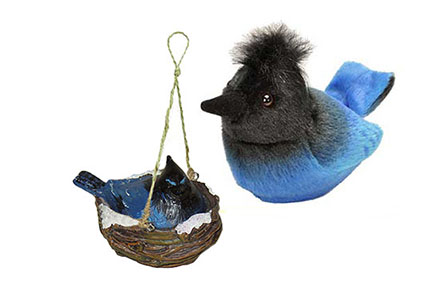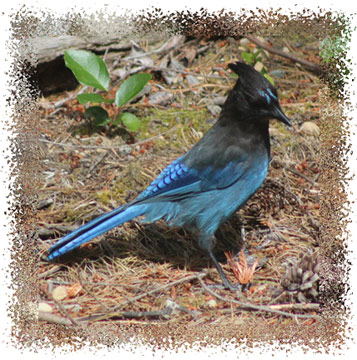

This plush toy Steller's Jay and Steller's Jay ornament can be found at our sponsor's online Gift Shop.
The Steller's Jay, cyanocitta stelleri, has a conspicuous crest and attractive blue and black plumage. There is black banding on the tail and wings. This jaunty-looking intelligent 12 to 13-inch bird is the only western jay with a crest.
The bird is named after the naturalist, George Steller, who discovered the birds on an island in Alaska in 1741.
Steller's jays are bold creatures, as you can tell when you hear their noisy screams as they roam through coniferous forests and woodlands in search of food. Always ready to mob a sleepy owl or to follow and torment a fox, they eat almost anything, insects, grain, fruit, and acorns. In the spring they add the eggs and young of small birds to their bill of fare.
Both male and female take part in building the nest and feeding the young, but only the female incubates the eggs. This is generally true of all the birds of this family. While the female Steller's jay is incubating the eggs, she is sometimes fed by her mate. The incubation period is about 16 days. There is one brood produced each year. The young are fully fledged in 6 weeks. The substantial nest is built of sticks, lined with finer materials, and sometimes held together with mud. The four or five eggs are mottled with green. Steller's jays hide their nest carefully, and they are quiet and furtive in its vicinity unless danger threatens - then they sometimes launch a courageous counterattack.
Great mimics, they are capable of mimicking the sounds of hawks, eagles, squirrels, cats, dogs and others. Their range is in the West from Alaska to Nicaragua. Steller's Jays can live to the ripe old age of 16. They are very social birds, traveling in groups.
Order: Passeriformes, Family: Corvidae, Genus: Cyanocitta, Species: C. stelleri




